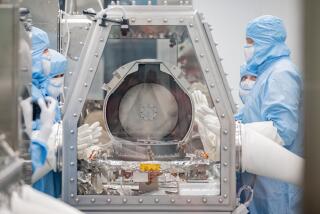NASA: 10,000 near-Earth objects found — at least 100,000 left to go
The database of asteroids and comets that can pass near the Earth has hit a new milestone: This week, NASA announced that a powerful telescope in Hawaii detected the 10,000th near-Earth object on June 18.
Now, the agency wants asteroid hunters to find 100,000 more.
A near-Earth object (NEO) is an asteroid or comet that can pass within 28-million miles of the Earth. Size doesn’t have much to do with the NEO designation — according to NASA, a near-Earth object can be just a bit bigger than a basketball or as large as 25 miles across, like the mega near-Earth asteroid 1036 Ganymed.
Quiz: Test your asteroid knowledge
Asteroids and comets bigger than a kilometer (about 2/3 of a mile, or 3,281-feet) are the ones that would cause major global problems if they struck the Earth, said Don Yeomans, who heads up NASA’s Near-Earth Object Program office at the Jet Propulsion Laboratory.
The good news is that 95% of those have already been found, and none of those giant asteroids are expected to hit Earth in the next 100 years.
But there are an estimated 15,000 NEOs that are 460 feet long, or the size of 1½ football fields, and more than a million that are 100 feet long. And even a 100-foot-long asteroid could cause major devastation if it were to hit a populated area.
“Finding 10,000 near-Earth objects is a significant milestone,” said Lindley Johnson, of NASA’s Near-Earth Object Observations Program in a statement. “But there are at least 10 times that many more to be found before we can be assured we will have found any and all that could impact and do significant harm to the citizens of Earth.”
Yeomans put it more simply: “We definitely have a lot more to go,” he told the Los Angeles Times.
The 10,000th asteroid to be discovered is a 1,000-footer dubbed 2013 MZ5. It was discovered by the Pan-STARRS-1 telescope located on a 10,000-foot summit in Maui. Yeomans said scientists don’t know much about the asteroid, but its orbit is well understood and it will not hit Earth within the next 100 years.
He added that new NEOs are being found at a rate of about three a day. When one is discovered, scientists immediately try to calculate its orbit to see if it could hit Earth.
If they found one that might hit the Earth 20 or 40 years in the future, they might be able to deflect it by ramming a spacecraft into it a decade or two before its scheduled impact and bump it off course, said Yeomans.
ALSO:
NASA wants you to help save Earth from a deadly asteroid
Asteroid capture: NASA plans to drag space rock into lunar orbit
Three super-Earth planets found in habitable zone of nearby star







